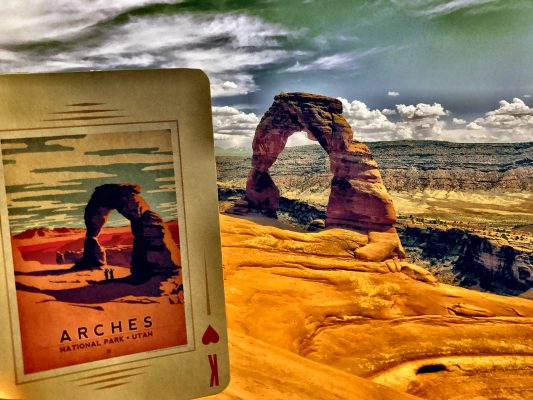
Arches National Park
With Outrider Melissa Schmitz
Arches National Park
A Pathfinder does not simply blaze out the way for himself. He lays down a clear route for others to follow. Therefore, there is tremendous gratification to be able to share the trail with fellow wanderers. My first Happening outrider, Melissa Schmitz, arrived just as I was transitioning from colorful Colorado into the rugged mesas and ruddy canyons of Utah. It was a drastic and sudden series of changes. Cool mornings yielded to a scorching heat. Aspens and rolling green prairies gave way to crumbling red sandstone, and the peaceful solitude resigned to a massive crowd of tourists and recreational enthusiasts. Moab is one of the most isolated towns in the United States so it came as little surprise that the crowds were heavy. It is a go-to mecca for off-roading, mountain biking and white water. Not to mention some of the most visually satisfying geologic features in the country but peaking at one hundred and six degrees in early June, it was the temperature that really got our attention.
We based out of Grand Junction, Colorado and drove along the Colorado River along route 128 each morning. I had considered boondocking in one of the parks closer to Moab but the desire to maintain an option for A/C left me with few alternatives in lieu of the crowds. The choice proved a wise move as the sun and heat were relentless and there had hardly been time to reacclimate from the recent cool weather farther East and the evening cool-down was needed to avoid dehydration and over-heating. The drive was spectacular and we caught the early morning shadows as well as the sunset each evening upon our return. The ride also took us through a curious little ghost town that was populated by a single young antelope, we dubbed “the Mayor” as we speculated the fate of the abandoned structures past inhabitants. We explored Arches first as a portion of the park was under construction and closed to the public for the entire summer season. The park has limited roadways and very few trails to begin with so while we were unable to explore the “Devil’s Garden”, we could take in most of the other available highlights not restricted by improvements underway. “Living Earth”, the park described ecosystem found in the area, is adversely impacted by contact thus limiting the practicality of traversing around randomly in the park and subsequently allowing for easy coverage in a single day.
Crowning a massive underground salt bed, Arches National Park is just shy of seventy-seven thousand acres of scrub covered sandstone filled with the world’s largest concentration of curved arches, etched spires and balanced rocks. Located on the Colorado Plateau at an elevation of around fifty-six hundred feet, the park has a rich geological history. Over two-thousand arches are located within the boundaries of the park and the number is ever changing. Since 1977, forty-three arches have fallen to erosion or mankind’s negligence. Even the late Dean Potter, known for his controversial adrenaline-poaching activities, caused an uproar after a free solo of ‘Delicate Arch”, one of the most widely photographed geological features in the world. Park authorities have since been required to implement strict rules governing the feature rich park to ensure its continued integrity yet even that will not stop rain and ice from deconstructing the beautiful striated wonders back into sands to be carried away by the wind and wash over time.
The human record has also left a diversified mark on the landscape over the millennia. The area is believed to have been inhabited by one form of human or another since the last ice age, some ten thousand years ago. Fremont Peoples, Pueblo, Ute, Paiute, Euro-Americans and eventually Frank Wadeigh, cited with exposing the park to the government at the invitation of Hungarian prospector, Alexander Ringhoffer. Both men possessed an inclination for the tourist potential of the area and sought it protected. Through the years, several presidents took additional efforts to protect and expand the area as a monument, however, Arches was not designated a National Park until November of 1971.
We cruised along the by-way and took in “The Three Gossips” and “the Tower of Babel”. We hiked to “Double Arch”, “The Garden of Eden”, and the “Parade of Elephants” and climbed about the rocks. We explored the crevices around “Sand Dune Arch” and passed by the “Balanced Rock”. We braved the sun on the three-mile stroll to look through “Frame Arch” and see the World-Famous, “Delicate Arch” and relax in the shade of a curved ridgeline carved out of the stone. It is a landscape of Seussian design that defies the comprehension and stimulates the sight. Arches is one of those parks that everyone should see…and sooner rather than later. With the collapses recorded to date and the rapidly changing climate, this is truly a park marked by a moment in time and the Arches we have come to know and enjoy will eventually crumble and fall. On a lighter note, with any luck and a mind towards limiting human impact, new arches should form of the existing fins and ridgelines of today making for an ever-changing playground for generations to explore and enjoy in the future. Take lots of water and start early to avoid the crowds.
Ruck n roll…
